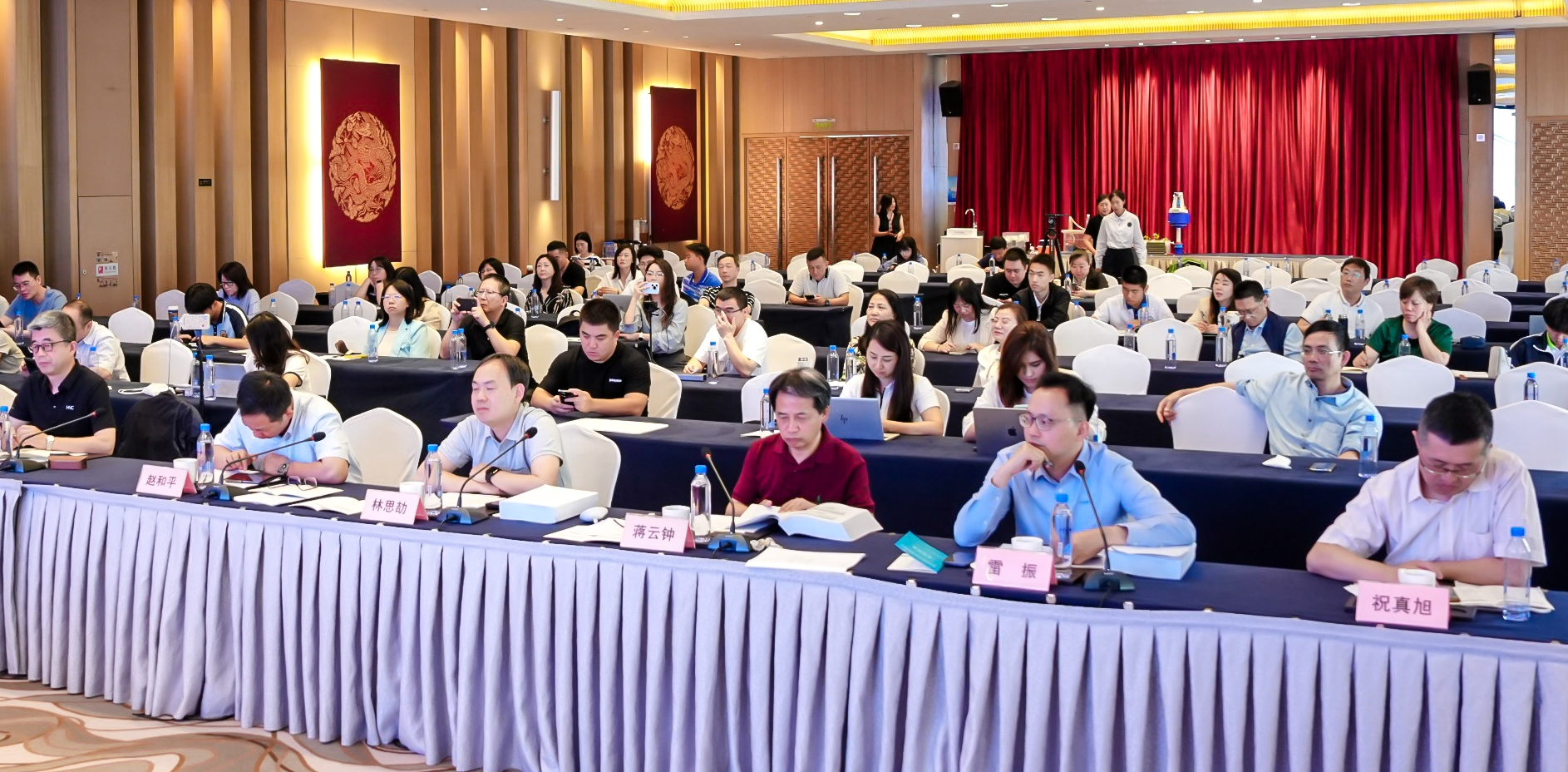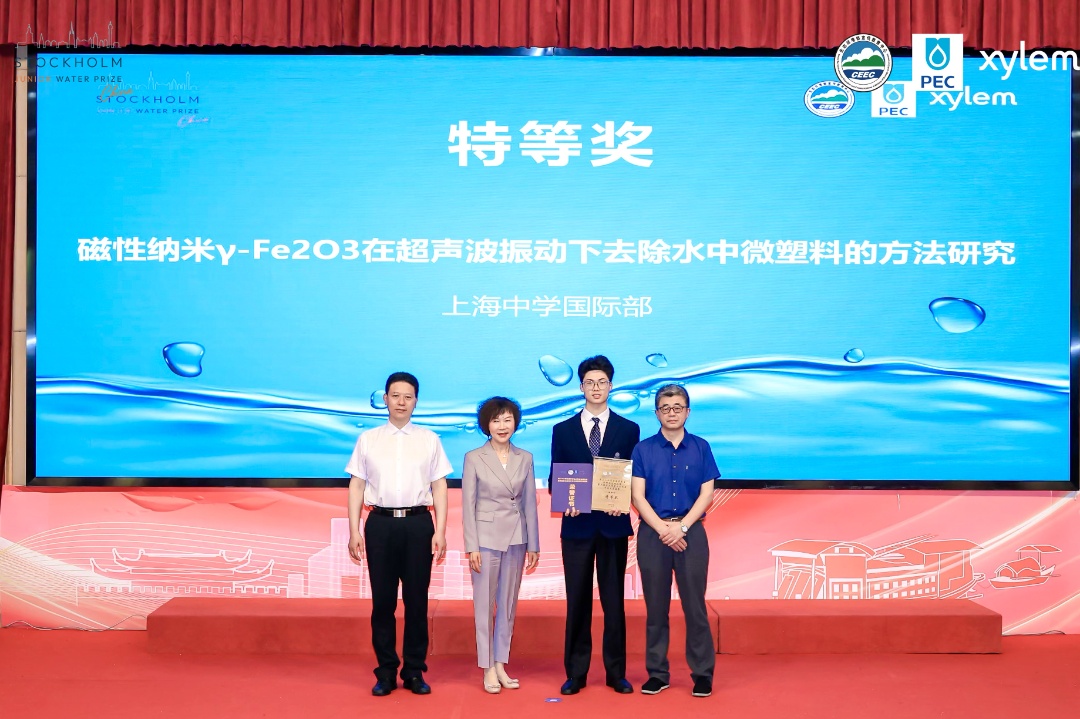On this stage of intellectual endeavor, twenty-three(23) project teams from nineteen(19) provinces (autonomous regions, and municipalities) across China embarked on a magnificent journey of innovation in water protection, fueled by a sincere passion for water conservation.
As the competition commenced, the 23 project teams ascended the stage in the order determined by drawing lots, vigorously striving for the highest honors of the finals. In this contest of intellect and creativity, each team was allotted only 5 minutes for their presentation, but faced a challenging 15-minute Q&A session conducted in both Chinese and English, where they addressed diverse questions posed by 10 professional judges. The young participants responded with composure, demonstrating solid professional knowledge and innovative thinking.

JIANG Yunzhong and other jury members
Jiang Yunzhong, Regional Secretary Executive of the Global Water Partnership China (GWP China), who served as a specially invited judge for the finals, highly praised the significance of the competition, summarizing it as "youth carving their innovative strokes upon clear blue waters." Reflecting on the selection process, he remarked, "Beyond the brilliance of the projects themselves, the contestants' on-the-spot performance was equally impressive. WU Peiyuan from Shanghai High School, who won the Grand Prize, answered fluently and accurately in English throughout. FENG Yuyao, an eighth-grade student from the High School Affiliated to Renmin University of China who also won first prize, independently handled everything from the PPT presentation and physical demonstration to the bilingual Q&A, exhibiting seamless flow and confidence. Similarly, TIAN Zechen, a sixth-grade student from Hefei Amschool in Anhui province who likewise won first prize, despite still being in elementary school and shorter than the podium, delivered a clear, logical explanation and switched effortlessly between Chinese and English. These truly fully demonstrate the caliber of the new generation of Chinese students."
Professor XU Linyu from the School of Environment at Beijing Normal University established rigorous and fair judging criteria for this technological event, stating, "We will evaluate projects based on quality, innovation in topic selection, and the contestants' on-site performance, particularly their language proficiency and ability to respond to professional questions."
A closer inspection of the list of projects shortlisted for the finals reveals a condensed "micro-encyclopedia" of modern water management technologies. The projects encompassed key areas such as water resource conservation and utilization, water environment management, aquatic ecosystem protection and restoration, and marine ecological conservation. Innovations like an Internet+-based smart ultrasonic water leakage detector with adjustable precision, an IoT-enabled intelligent rainwater harvesting and utilization system, and a solar-powered aeration-type constructed wetland water purification system vividly demonstrated the students' profound understanding and bold innovation in water technology.

WU Peiyuan at Q&A
Among the myriad of shining innovations, WU Peiyuan from Shanghai High School stood out with his project titled "Research on the Method of Removing Microplastics from Water Using Magnetic Nano γ-Fe2O3 Material under Ultrasonic Vibration," earning him the Grand Prize. Facing the increasingly severe challenge of microplastic pollution, WU adopted a novel approach. He discovered that under the intense vibration of ultrasound, magnetic nano γ-Fe2O3 material rapidly disperses in water, precisely adsorbing microplastics and achieving efficient removal. When confronted with professional questions from the judges, WU remained calm and answered fluently, "Based on our research from last year, we continuously refined the method to achieve more efficient, lower-energy consumption treatment while avoiding secondary pollution to the water body." His dedication and intellect shone brightly on the stage.
WANG Shuyu from Derun Campus of Shandong Experimental High School was also impressive. Focusing on Polybrominated Diphenyl Ethers (PBDEs), an emerging pollutant, she conducted in-depth research on pollution characteristics in the Pearl River, Yangtze River, Yellow River basins, and the Xiaoqing River (Jinan section) in Shandong. She boldly proposed an innovative idea to prepare PBDEs oxidation catalysts from waste straw, paving a new path for emerging pollutant treatment. These research projects closely align with national strategies for microplastic management, and the students' ingenious ideas serve as powerful weapons in the "battlefield" of microplastic control.
Innovative sparks flew throughout the competition. The "Spiral Propulsion Unmanned Surface Cleaning Vehicle" brought by XIONG Haochen and TIAN Zechen from Hefei Amschool in Anhui was the sole project from the Anhui division to reach the finals. Equipped with a spiral propulsion system, this cleaner can navigate complex waters such as rivers and mudflats with ease, automatically identifying, collecting, and classifying surface garbage, earning it the title of "intelligent guardian" of water cleaning. ZHANG Mengyue from Zhengzhou Foreign Language School in Henan presented the "Solar-Powered Sulfur-Based Autotrophic Denitrification Boat for In-situ Nitrogen Removal in Rivers and Lakes," providing an efficient and eco-friendly solution for nitrogen pollution in urban and rural water bodies, effectively curbing algal blooms and black, odorous water. The "AI Water Brain Emergency Response System with Full Environmental Perception" developed by LI Xuanbo and HU Chuyu from Yichun No.1 High School in Jiangxi province directly addressed the critical issue of thallium leakage emergency response, establishing a comprehensive process system from pollution identification to safety control, enabling rapid response and ultra-high removal rates.

Junior Innovators
JIN Yinan and WENG Luheng from Shaoxing No.1 High School in Zhejiang assisted the Shaoxing Ecological Environment Department in upgrading the biological monitoring system for canal water quality with their project titled "eDNA Diatom Monitoring Technology." FENG Yuyao from the High School Affiliated to Renmin University of China developed the "Water-Saving Washbasin and Smart Water-Saving Devices for Homes and Communities," demonstrating significant potential through an innovative design, opening a new chapter for household water conservation. LI Deng and SITU Fangqi from Zunyi No.1 High School in Guizhou presented the "Integrated Kitchen and Toilet Water-Saving Device," ingeniously giving wastewater a second life through smart drain design. The "Wave Energy-Driven Coral Restoration Buoy" designed by LI Peizheng and TONG Yueqing from Guangdong Experimental High School injected new momentum into marine ecological protection. Students CHEN Sirui and CHEN Siyu from Nanjing No.29 High School developed a "Low-Carbon Self-Circulating Aquaculture System," achieving multiple goals of water saving, pollution reduction, and carbon emission reduction, pointing the way for the green transformation of aquaculture.

WU Peiyuan Won Grand Finale
The expert judges unanimously agreed that this year's entries showcased both the inheritance and iteration of existing technologies alongside bold innovative breakthroughs, vividly illustrating the resonance between youthful ingenuity and national water management strategies. WU Peiyuan from Shanghai High School will soon represent Chinese youth at the world finals of the Stockholm Junior Water Prize during World Water Week 2025, ready to share China's story on the international stage and demonstrate the mission and responsibility of Chinese youth.
Although this technological gathering of youthful minds has concluded, the journey to safeguard our waters is endless. We believe that through the relentless efforts of these creative and responsible young people, our rivers, lakes, and seas will surely shine with even more captivating brilliance.
